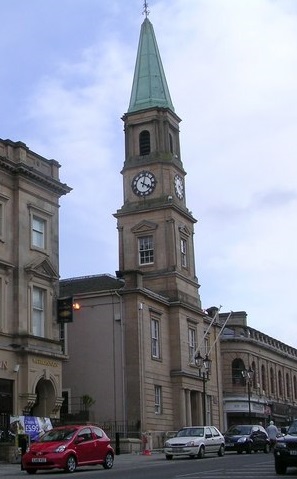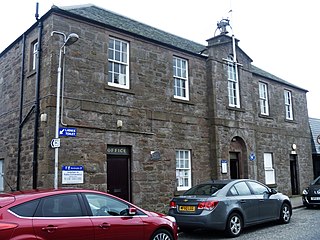
Whiteinch is an area in the city of Glasgow, Scotland. It is situated directly north of the River Clyde, between the Partick and Scotstoun areas of the city. Whiteinch was at one stage part of the burgh of Partick, until that burgh's absorption into the expanding city of Glasgow in 1912, and part of the Parish of Govan.

Partick Burgh Hall is a municipal facility in Burgh Hall Street, Partick, Scotland. The hall, which was the headquarters of Partick Burgh Council in the early 20th century, is a Category B listed building.

The Old Town Hall is a municipal building in Queen Charlotte Street, Leith, Scotland. The old town hall, which was the meeting place of Leith Burgh Council, is now used as a police station. It is a Category A listed building.

Airdie Town House is a municipal building in Bank Street, Airdrie, North Lanarkshire, Scotland. The town house, which was the headquarters of Airdrie Burgh Council, is a Category B listed building.

The Municipal Buildings are based on the north side of Princes Street East in Helensburgh, Scotland. The structure, which served as the meeting place of Helensburgh Burgh Council, is a Category B listed building.

Fraserburgh Town House is a municipal building in Saltoun Square, Fraserburgh, Scotland. The building, which was the headquarters of Fraserburgh Burgh Council, is a Category B listed building.

Saltcoats Town Hall is a municipal building in Countess Street, Saltcoats, North Ayrshire, Scotland. The building, which is used by North Ayrshire Council as hub for the delivery of local services, is a Category B listed building.

Inverbervie Town House is a municipal structure in Church Street in Inverbervie, Aberdeenshire, Scotland. The structure, which is primarily used as a public library, is a Category B listed building.

The Justiciary Buildings is a judicial complex in the Saltmarket in Glasgow, Scotland. The complex, which operates in conjunction with similar facilities in Edinburgh and Aberdeen, is dedicated for the use of the High Court of Justiciary, which is the supreme criminal court in Scotland. It is a Category A listed building.

Sanquhar Tolbooth is a municipal building in the High Street in Sanquhar, Dumfries and Galloway, Scotland. The structure, which accommodates a local history museum, is a Category A listed building.

Darvel Town Hall is a municipal building in West Main Street, Darvel, East Ayrshire, Scotland. The structure, which is used as a library and a community events venue, is a Category B listed building.

Falkland Town Hall is a municipal building in the High Street, Falkland, Fife, Scotland. The structure, which has been converted for use as offices and as shops, is a Category A listed building.

Inverkeithing Town House is a municipal building in the Townhall Street, Inverkeithing, Fife, Scotland. The structure, which is used as a base by members of the local community council, is a Category A listed building.

Crieff Town Hall is a municipal building in the High Street, Crieff, Perth and Kinross, Scotland. The structure, which is currently used as a tourist information centre and museum, is a Category B listed building.

Coldstream Town Hall is a municipal building in the High Street, Coldstream, Scottish Borders, Scotland. The structure, which currently accommodates a library and a registration office, is a Category B listed building.

The Justiciary Building is a judicial structure in the Lawnmarket in Edinburgh, Scotland. The structure, which operates in conjunction with similar facilities in Glasgow and Aberdeen, is dedicated for the use of the High Court of Justiciary, which is the supreme criminal court in Scotland. It is a Category B listed building.

Lanark Sheriff Court is a judicial building in Hope Street, Lanark, South Lanarkshire, Scotland. The building, which continues to serve as the local courthouse, is a Category B listed building.

Whiteinch Burgh Hall is a municipal building on Victoria Park Drive South in Whiteinch, part of Glasgow, Scotland. The burgh hall, which is currently derelict, is a Category B listed building.

Govan Municipal Buildings is a former local authority building on Orkney Street in Govan, Scotland. The building, which was the meeting place of the local burgh council in the 19th century, is a Category B listed building.

Ardrossan Civic Centre is a municipal building in Glasgow Street in Ardrossan, a town in North Ayrshire, Scotland. The building, which was previously the offices and meeting place of Ardrossan Burgh Council, is currently used as a masonic hall.





















